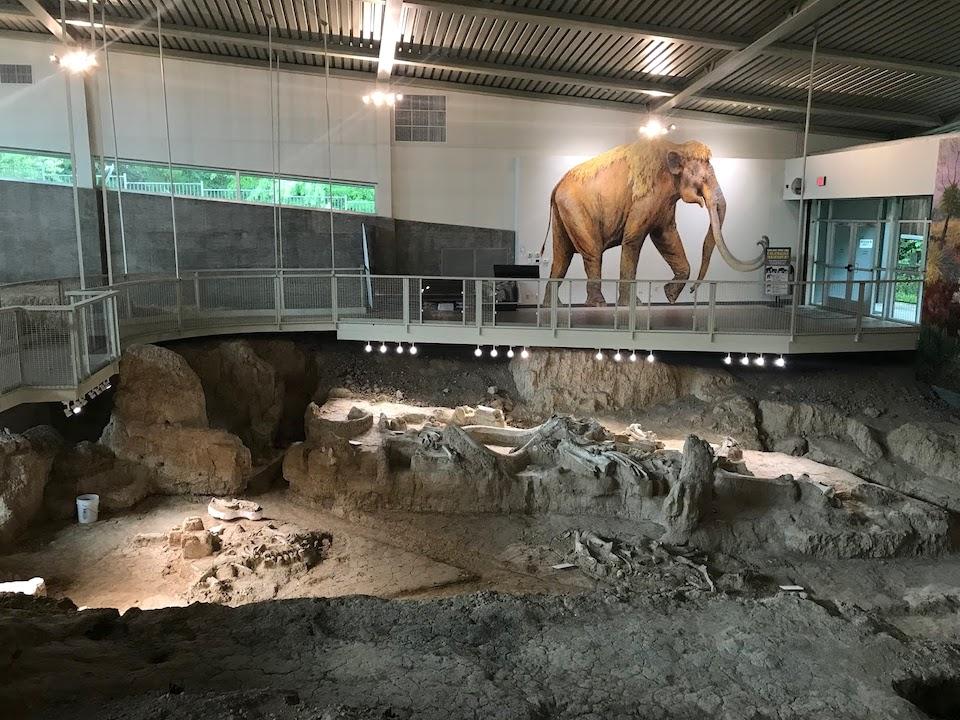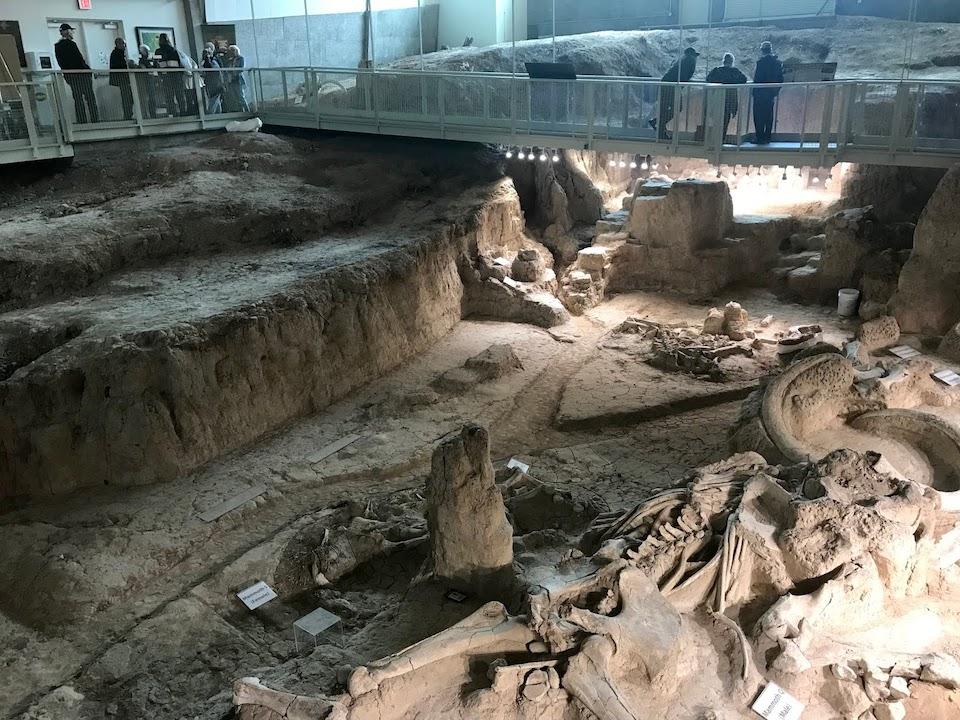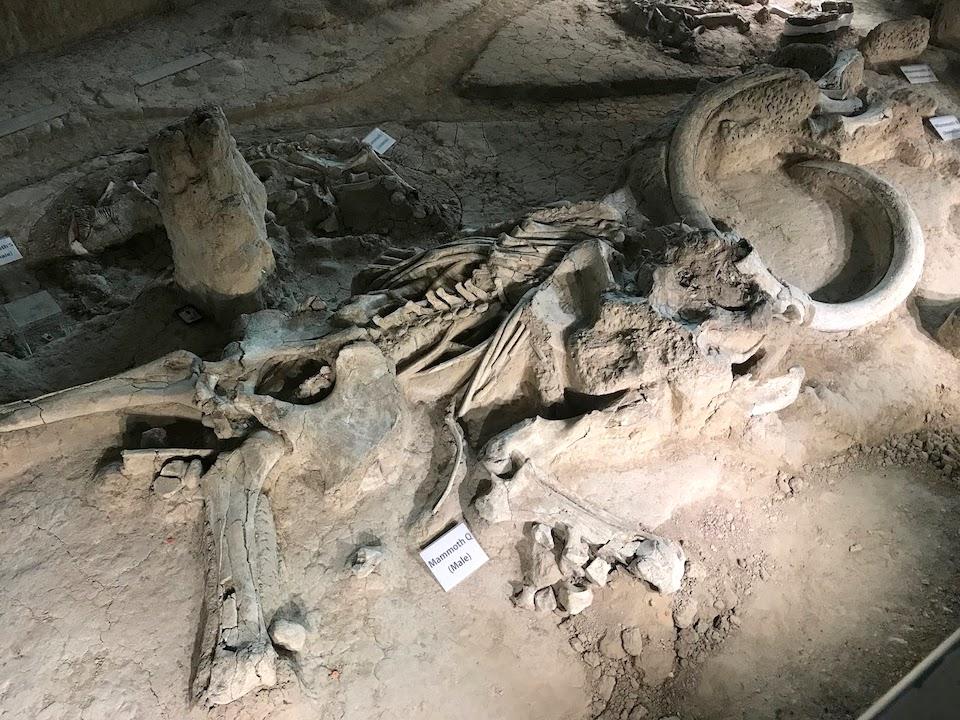
View across the Dig Shelter at Waco National Monument/Jim Stratton
Columbian Mammoths Up Close And Personal Bring A Fresh Perspective To A City With An Unfortunate Past
Until just a few years ago, when I thought of Waco, Texas, Columbian mammoths did not come to mind. Instead, there was that unfortunate law enforcement action in 1993, and I’m told there is a very popular house renovation show, Fixer Upper, on HGTV that is based in Waco. Neither of these would have motivated me to visit Waco, but I remembered my Texas-based National Parks Conservation Association colleague Suzanne Dixon enthusiastically working on President Obama’s 2015 Antiquities Act Proclamation to add Waco Mammoth National Monument to the National Park System. She waxed eloquently about this site, and I finally got to check it out on my own.
My girlfriend Craig and I were taking a tour of Texas in our little Alto trailer and we camped at Speegleville Park, a really nice and centrally located Army Corps of Engineers campground on Lake Waco. We had reservations for two nights and were glad we did. The park was full of people like us escaping the cold climates of more northerly latitudes. Eagerly anticipating learning about mammoths in Waco, we were up early the next morning and headed for the site.
The Waco Mammoth story begins when a flash flood, mudslide, or some other natural catastrophe, possibly even a drought, killed a nursery herd of 18 adult female and young Columbian mammoths about 65,000 years ago. Whatever the event, it covered this nursery herd quickly. We know this because they were all found together and encased in mudstone, in a ravine about five miles from downtown Waco along the Bosque River. This small herd laid entombed until 1978 when Paul Barron and Eddie Bufkin found a large fossil sticking out of the ground as they were searching the area for arrowheads. They took it to scientists at Baylor University who quickly recognized it as a Columbian mammoth femur bone. It was and is the only mammoth nursery herd found in North America.
I really didn’t know much about mammoths other than they were walking around North America and being hunted 10,000 years ago, and that several almost intact mammoths had been found in the frozen tundra of Siberia. Until my visit, I hadn’t fully realized there are different species of mammoth. I am most familiar with the woolly mammoth found in northern climates, like my home in Alaska. And on a recent trip to St. Paul Island in the Bering Sea, I learned that woolly mammoths walked on that island as recently as 5,700 years ago, and that on Wrangell Island further north near Russia, the last of the wooly mammoth died only 3,700 years ago.

Ice age mammoth bones in situ/Jim Stratton
But woolly mammoths are small compared to the ones in Waco. Turns out that Waco’s Columbian mammoths are half again as big as their northern cousins, standing around 14 feet at the shoulder and weighing up to 10 tons. As a size comparison, today’s largest African elephant stands about 13 feet. Scientists studying the remains of Columbian mammoths figure that daily they ate 300 to 700 pounds of food, drank 50 gallons of water and created 400 pounds of fertilizer!!
Baylor University organized the dig along the Bosque River, and they have removed all of the bones found there, storing them for future study. Baylor spent 12 years excavating the site. After excavation, there was a large hole in the ground that needed to be filled in. When the dirt movers started on that project, moving dirt from an adjacent location, they discovered more bones of mammoths and other Ice Age animals.
There were three different events over a 15,000-year period that caused animals to die at this location and be covered in mud. These fate-struck animals included saber-toothed cats, camels, and several more Columbian mammoths. The bones found adjacent to the nursery herd were not removed once they were uncovered. They were left in situ, and these are the bones you can see today. Since 2004, the Waco Mammoth Foundation has led the effort to preserve these new finds for public education and enjoyment.
Fortunately, the landowner realized this was a world-class mammoth site and, in 1996, donated the initial five-acre site to the city of Waco. In subsequent years, Baylor University acquired additional acreage around the site, raising the total protected acres to 108. The Waco Mammoth Foundation, in cooperation with the city of Waco, raised the necessary funds to build a shelter over the top of this newer site and its welcome center. Waco Mammoth was first opened to the public in 2009. Baylor University continues to be involved in the research and preservation of the bones.
Visiting the climate-controlled Dig Shelter requires a guide. We arrived at the welcome center and checked in to purchase our tickets for the next guided walk. There is a nominal fee that goes to the city of Waco to pay for the guides, so your America the Beautiful passes don’t work here. The guides actually work for the city. It is open seven days a week, and the tours leave regularly throughout the day. This is a great example of a working partnership between local government, academia, local NGOs and the Park Service. The local congressman started advocating for including Waco Mammoth in the National Park System in 2010, and it passed the House of Representatives twice, only to die in the Senate. President Obama desingated the site a national monument in 2015.
Our guide met us under a covered area next to the welcome center for the start of the story. We walked along a paved path over the stream bed where the nursery herd was found, and into the covered Dig Shelter. It is not huge, and the whole visit took us less than two hours. Just inside the Dig Shelter you find yourself on an elevated walkway where you can peer down on a gigantic male mammoth lying in the ground just 10 feet or so below you. This big guy was covered up in the last of the three events that buried animals here. With only a little bit of imagination, you can visualize the flesh and hair on the skeleton as the shaggy beast lying on the ground comes to life. To help, there is a mural on the wall of what scientists think they looked like.
Nearby, there is a skeleton of a camel; we learned camels are regularly found with mammoths. Scientists speculate that camels were part of the early warning predator alert system. Assuming mammoths are like elephants, they can’t see well. But the camels can. So when the camels became agitated by approaching predators (including humans), the mammoths were alerted. In return, the camels found safety by hanging out with the mammoth herd.
You can stay as long as you want gazing at bones (there are several other skeletons uncovered for visitors to see), so long as a guide is there. Our guide moved on to shepherd his next group and we stayed longer when the next group arrived in the shelter.

Large bull Columbian mammoth left where he fell 50,000 years ago/Jim Stratton
Our visit was over before noon and the weather was marginal, so we snuck in a hike at the Lake Waco Wetlands, a city owned nature preserve that was built in 2007 to mitigate wetland loss when Lake Waco was raised seven feet. There is a nature center and boardwalks to take you out into the wetlands for some good bird and turtle viewing. Painted buntings were the highlight of our walk before the weather turned to rain and we scooted back to the car and an afternoon of indoor activities.
If you have the time, I strongly recommend the Texas Ranger Hall of Fame and Museum, our afternoon indoor activity. Craig was a little skeptical about this, but once we got there, the history and stories told were captivating. The Texas Rangers are one of the oldest law enforcement agencies in America, having been formed in 1823 by Stephen F. Austin to protect settlers moving into Indian country. Of course, the Comanche were just trying to protect their home from Texans pushing west. This museum tells dozens of Texas Ranger stories, even the ones where the Rangers are not the men you would point to for their virtue and honesty. So warts and all, you get the whole Texas Ranger story…including the demise of Bonnie and Clyde and John Wesley Hardin.
Waco Mammoth National Monument got me to Waco where my perception of the city really changed. I am sure the city fathers and mothers are much happier to be known for mammoths.

 Support Essential Coverage of Essential Places
Support Essential Coverage of Essential Places







Comments
Thank you so much for your positive comments about Waco. Our family has lived here for two decades and we are proud to call it home.
Columbian mammoths weren't shaggy.
i live about three miles from the site I am glad that is part of the National Park it deserves beeing included